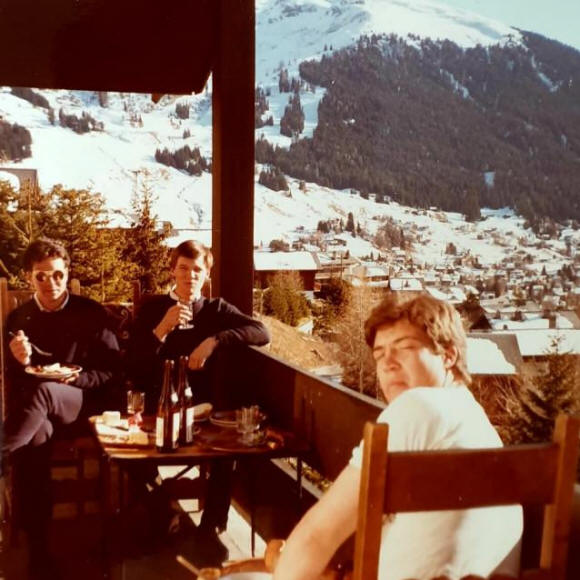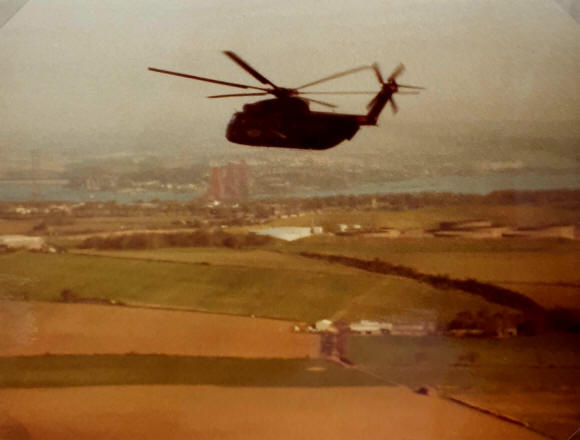|

I
WOULDN’T want you to think that the life of a subaltern
in the #BARITWE was all work and no play, mind. All that
stravaiging around the countryside in big, heavy metal
beasts took up only part of our energies, although we
spend much more time out of barracks and on our panzers
than today’s tankies do, by a long shot. Likewise, there
did come a point where there was little more to be done
on the tank park, our troop sergeant’s domain of course.
We couldn’t spend all our time between exercises
painting stones and sweeping leaves otherwise there
would have been, quite rightly, a mutiny.

German taxi service
Thank
goodness, then, for jollies and adventure training. The
former tended to be one-off, ad hoc taskings that might
be allocated to a junior officer as part of their
general military education or, more often, because more
senior officers didn’t fancy them. Examples might be
escorting an officer or delegation from a foreign
military as they visited the Regiment, brigade or
division. These tended to be the more boring ones,
although if you were a “thruster” you would welcome the
opportunity they sometimes presented to come to the
attention of your reporting officer further up the
command chain. Others were much more light-hearted and
fun; escorting “Miss 4RTR” on her annual visit to the
Regiment might fall into that category, although
officers were usually warned off from becoming too
intimately involved with their charges. It did happen
though.
Bigger jollies came in a variety of shapes and sizes.
The one I was tasked with as a young officer involved
taking a Chieftain tank plus crew and support vehicles
to the south of France as the UK contribution to the
MILAN thermal imaging sight trials. MILAN (Missile
d'infanterie léger antichar) was the infantry’s standard
anti-tank missile at the time, and the newly developed
thermal imaging (TI) sight was being trialled by a team
from the Infantry Trials and Development Unit (ITDU),
based at Warminster. They needed to trial it in all
weather conditions, and the wet weather trials were
carried out, with us providing the target tank, at
Meppen on the North German plain, one of the most
depressing places I have ever had the misfortune to
visit. It rained non-stop.
The warm weather trials, on the other hand, were carried
out at the French army base near Draguignan, a commune
in the Var department in the Provence-Alpes-Côte d'Azur
region, in southeastern France, and a mere 26 miles
inland from St Tropez. Haud me back, as we used to say.
Getting there was fun. The CO’s tank was chosen for the
job, together with two REME repair and recovery vehicles
and a spare Chieftain power pack such were the concerns
over reliability, and duly departed by rail for the
south of France. The route was hardly direct and
dictated by the width of various railway bridges along
the way, consequently taking several days.
I went with the road party in a couple of land rovers
and a 4 tonner. It took a long time, given the speed
limit restrictions on military vehicles in France, and
we did get the odd curious stare from the French police
as we made our way south, but it was pretty
straightforward. I recall we had an overnight stop with
the 75eme Regiment d’Infantrie in their barracks at
Valence (where I think its fair to say we found the food
in their canteen “interesting”) then arrived at Canjuers
Camp, at the time the biggest military camp in Europe at
350 km2. Julius Caesar had established the first
military presence there during his conquest of Gaul in
the first century BC.
Getting the Chieftain up the hill to camp from the
railhead was a bit of a nightmare given the narrowness
of the road and the steepness of the climb, but we got
there in the end after holding up the local traffic for
a couple of hours. And once we were there it was pretty
relaxed and plain sailing. The Germans, of course,
arrived a day after us and just drove their Leopard 1
and Marder IFV up the hill no bother, switched off and
went away for lunch. There was not much for me to do
when the tank was out on the range being driven up and
down for the benefit of the trial, except “be in
charge”. Which was fine. Overall command of the British
contingent fell to a major from the Gurkhas, but he was
very odd and I spent as little time as I could in his
company.
We spent an awful lot of time on the beach at St
Raphael, which was lovely, and in various little cafés
and estaminets in the local area. I learned that
escargots Perpignan were not always served in their
shells, and that the locals liked their red wine un peu
glacé. The boys’ standard order was “steak frites wi’ a
fried oeuf on top an’ nae pine needles” – that is no
herbs – “s’il vous plait”. We were very polite and had a
nice time for several weeks. Getting back to Munster was
a bit of an ordeal for the tank crew who travelled by
rail with the vehicles. For unknown reasons they got
stuck in sidings somewhere for weeks before they finally
made it home.
Then there was adventure training, usually referred to
as “adventure drinking” by all. This was (is?) an army
wide activity designed to provide energetic and
challenging training for those stuck in barracks or in
between exercises in the field. The definition of what
constituted adventure training was pretty wide, and it
was seen primarily as a means for young officers to take
their troops or platoons away somewhere different to do
something interesting away from the beady eyes of the
immediate chain of command. Provided you could persuade
your OC or CO that your scheme was a good idea and it
fell within the regulations you were on your way.
Many weird and wonderful schemes came to pass under the
general banner of adventure training. People went
trekking, climbed mountains, learned how to sail, and
visited strange locations, and it was a good thing. But
inevitably it was open to exploitation and abuse. One
famous trip to motorcycle through Europe and then across
the Mediterranean to Morocco and explore the Atlas
Mountains got as far as the Cote d’Azur and stayed
there, while spurious progress reports were sent back
from time to time detailing the rigours of North Africa.
Very rarely if ever did anyone check that what had been
proposed had actually been carried out, and as long as
you submitted a convincing post-exercise report no-one
was ever any the wiser.
Such jollies were funded partially from central
adventure funds and partly by the individuals
participating. But there was also the great gift from
above that kept on giving, namely CILOR, or “cash in
lieu of rations”. Normally soldiers’ payment for rations
in barracks was deducted at source from their pay; it
was subsidised much in the way that meals are subsidised,
for example, for MSPs in the Scottish Parliament (and
alcohol is too, by the way, but they don’t like you to
talk about that), but nonetheless payment was made. On
adventure training, however, away from barracks, you
could apply for CILOR and receive sometimes a
considerable sum of money to sustain the troops whilst
on their chosen activity. It all had to be accounted for
properly, of course, by the expedition leader and I very
much doubt if anything underhand happened with the
expenditure of funds so received. However, there were
always buckshee ration packs in abundance around the
barracks and, if all were agreed to exist on “compo” for
part of the time, there was ample opportunity to use
some of the CILOR for other associated activity, if you
get my drift. Alternatively, you could agree to starve
for a couple of days and then all go to the local
restaurant or café for a blow-out, dependent on tastes.
Did adventure training fill its intended remit? I
believe it did, and tales of the scrapes and
difficulties faced and surmounted on such ventures are
legion. Sadly space permits their recounting here, but
perhaps another time. They were a welcome part of a
young subaltern’s life back in the day and an important
part of the growing up process in uniform. We had fun,
that’s for sure.
To come in Part 12; farewell 13 Troop, hello Command
Troop, and the move back from Munster to Tidworth,
Wiltshire.
© Stuart
Crawford 2020
*BARITWE – Best Armoured Regiment In The World Ever |
